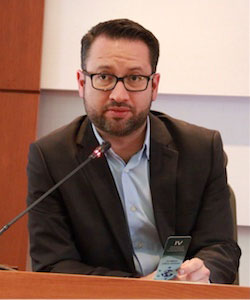Colombia is experiencing one of its greatest moments of contradiction in its history as a republic. Last year, the government signed a peace agreement with the oldest guerrilla movement in Latin America, the Revolutionary Armed Forces of Colombia (Fuerzas Armadas Revolucionarias de Colombia, FARC), which is in the process of becoming a political party called the Common Alternative Revolutionary Force (Fuerza Alternativa Revolucionaria del Comun, FARC). At the same time, public opinion of state institutions is at an all-time low. Specifically, a recent Gallup poll found that 72 percent of Colombians disapprove of their Supreme Court, 83 percent disapprove of the judiciary system, 87 percent disapprove of the political parties, and 72 percent disapprove of President Juan Manuel Santos, winner of Nobel Peace Prize.
Therefore, when Pope Francis arrived for a five-day visit to Colombia, including stops in Bogotá, Villavicencio, Medellín, and Cartagena, the atmosphere was defined by pessimism between citizens and heightened levels of elite polarization. During his apostolic journey, the Pope promulgated powerful messages of hope and reconciliation, especially during his meetings with the poor, young people, and victims of violence, where he synthesized the social doctrine of the Catholic Church through eye-catching Buenos Aires expressions.
Politically speaking, the most powerful messages were his insistence that Colombians reject all forms of violence and his emphasis on the mutual dependence between peace, justice, and truth, and above all, the need for forgiveness and reconciliation. In Villavicencio, he stated, “hatred does not have the last word […] love is stronger than death and violence.” To this end, the Pope beatified two martyrs of political violence: Pedro María Ramírez, a Catholic priest who was lynched after the murder of presidential candidate Jorge Eliécer Gaitán, and Bishop Jesús Emilio Jaramillo, who was murdered by Colombia’s second largest guerrilla group, the National Liberation Army (Ejército de Liberación Nacional, ELN), which is right now involved in a new peace process with the Colombian government. Even during his visit, proponents and critics of the peace agreement emphasized only the portions of the Pope’s messages that coincided with their political positions. These self-serving interpretations missed the Pope’s key message of the reconciliation for all, which employed social and cultural symbols to emphasize the unity of the Colombian people.
On the other hand, in recent years, the relationship between politics and religion in Colombia has been greatly debated. For example, the Constitutional Court recently ruled on issues relating to same-sex marriage, euthanasia, and public financing of religious celebrations, and the minister of education promoted a gender policy in schools that caused thousands of citizens to reject it with street demonstrations. The public role of religion was surprisingly telling when a political alliance was formed between evangelical groups and conservative Catholics who rejected the referendum for the peace agreement on October 2, 2016. In this post-secular country where the boundaries between politics and religion are porous, the Pope’s visit left us two things to ponder. First, an unprecedented number–6.8 million people according to official estimates–came out to see the Pope. Second, even politicians and public intellectual non-believers acknowledged their sympathy with Pope Francis’ message. Therefore unlike in some secularized societies, in Colombia there were no demonstrations against the Pope. It is a clear indication of his charismatic demeanor that even secular fundamentalists made an effort to listen the Pope’s message, and it proves a wrong prediction of secularization theory.

